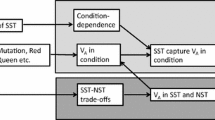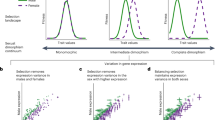Summary
Using a phenotypic model, we show that significant heritable variation can be maintained in a population subjected to temporally fluctuating selection if only one sex is subject to selection. In fact, more variation is maintained with sex-limited selection at a given selection intensity than if both sexes are subject to half that selection intensity. This result is commensurate with existing population genetic models. However, genetic models may be inappropriate for sexually selected traits because many of them may be of non-genetic origin, such as maternal effects or — more likely — epigenetic effects. Phenotypic models obviate this problem by accommodating both genetic and epigenetic effects, as well as maternal effects. Our phenotypic model of sex-limited temporally fluctuating selection shows that substantial heritable variation can be maintained and thereby provides impetus to develop population epigenetic models.
Similar content being viewed by others
References
Airey, D. C.; Castillo-Juarez, H.; Casella, G.; Pollak, E. J.; DeVoogd, T. J. (2000) Variation in the volume of zebra finch song control nuclei is heritable: developmental and evolutionary implications. Proc. R. Soc. Lond. Ser. B. 267: 2099–2104.
Bertram, S. M. (1999) Understanding intrapopulation variation in the mating behavior of a field cricket. Dissertation, Arizona State University, Tempe, pp 92.
Bertram, S. M. (2002) Temporally fluctuating selection of sex-limited signaling traits in the Texas field cricket, Gryllus texensis. Evolution 56: 1831–1839.
Boyes, J.; Bird, A. (1992) Repression of genes by DNA methylation depends on CpG density and promoter strength: evidence for involvement of a methyl-CpG binding protein. EMBO J. 11: 327–333.
Chandra, H. S. (1985) Is human X chromosome inactivation a sex-determining device? Proc. Natl. Acad. Sci. USA 82: 6947–6949.
Charlesworth, B. (1984) The evolutionary genetics of life histories. In: Shorrocks, B. (ed) Evol. Ecol. Blackwell, Oxford, pp 117–133.
Charlesworth, B. (1987) The heritability of fitness. In: Bradbury, J. W.; Andersson, M. B. (eds) Sexual selection: testing the alternatives. Wiley, Chichester, U.K., pp 21–40.
Charlesworth, B. (1991) The evolution of sex chromosomes. Science 251: 1030–1033.
Cheptou P. O.; Mathias, A. (2001) Can varying inbreeding depression select for intermediary selfing rates? Am. Nat. 157: 361–373.
Chorney, M. J.; Chorney, K.; Seese, N.; Owen, M. J.; Daniels, J.; McGuffin, P.; Thompson, L. A.; Detterman, D.K.; Benbow, C.; Lubinski, D.; Eley, T.; Plomin, R. (1998) A quantitative trait locus associated with cognitive ability in children. Psychol. Sci. 9: 159–166.
Crouse, H. V. (1960) The controlling element in sex chromosome behavior in Sciara. Genetics 45: 1429–1443.
Cubas, P.; Vincent, C.; Coen, E. (1999) An epigenetic mutation responsible for natural variation in floral symmetry. Nature 401: 157–161.
Demeulemeester, M. A. C.; Van Stallen, N.; De Proft, M. P. (1999) Degree of DNA methylation in chicory (Cichorium intybus L.): influence of plant age and vernalization. Plant Sci. 142: 101–108.
Dempster, E. R. (1955) Maintenance of genetic heterogeneity. Quant. Biol. 20: 25–32.
Derreumaux S.; Chaoui, M.; Tevanian, G.; Fermandjian, S. (2001) Impact of CpG methylation on structure, dynamics and solvation of cAMP DNA responsive element. Nucleic Acids Res. 29: 2314–2326.
Ellner, S. (1996) Environmental fluctuations and the maintenance of genetic diversity in age or stage-structured populations. Bull. Math. Biol. 58: 103–127.
Ellner, S.; Hairston, N. G. (1994) Role of overlapping generations in maintaining genetic variation in a fluctuating environment. Am. Nat. 143: 403–417.
Ellner, S.; Sasaki, A. (1996) Patterns of genetic polymorphism maintained by fluctuating selection with overlapping generations. Theor. Popul. Biol. 50: 31–65.
Ellner, S. P.; Hairston, N. G.; Kearns, C. M.; Babai, D. (1999) The roles of fluctuating selection and long-term diapause in microevolution of diapause timing in a freshwater copepod. Evolution 53: 111–122.
Eshel, I.; Feldman, M. W. (1982) On evolutionary genetic stability of the sex ratio. Theor. Popul. Biol. 21: 430–439.
Eshel, I.; Feldman, M. W.; Bergman, A. (1998) Long-term evolution, short-term evolution, and population genetic theory. J. Theor. Biol. 191: 391–396.
Falconer, D. S. (1981) Introduction to quantitative genetics (2nd edition), vol 2. Ronald Press, London.
Finnegan, E. J. (2002) Epialleles: a source of random variation in times of stress. Curr. Opin. Plant Biol. 5: 101–106.
Fisher, R. A. (1930) The genetical theory of natural selection. Clarendon Press, Oxford.
Gahr, M.; Metzdorf, R. (1999) The sexually dimorphic expression of androgen receptors in the song nucleus hyperstriatalis ventrale pars caudale of the zebra finch develops independently of gonadal steroids. J. Neurosci. 19: 2628–2636.
Giancotti, P.; Grappelli, C.; Poggesi, I.; Abatecola, M.; de Capoa, A.; Cozzi, R.; Perticone, P. (1995) Persistence of increased levels of ribosomal gene activity in CHO-K1 cells treated in vitro with demethylating agents. Mutat. Res. Lett. 348: 187–192.
Gillespie, J. H. (1982) A randomized SAS CFF model of natural selection in a random environment. Theor. Popul. Biol. 21: 219–237.
Gillespie, J. H. (1989) Could natural selection account for molecular evolution and polymorphism? Genome 31: 311–315.
Gorelick, R. (In press) Confounding comparative epigenomics. Genome Res.
Gorelick, R. (2003) Evolution of dioecy and sex chromosomes via methylation driving Muller’s ratchet. Biol. J. Linn. Soc. 80: 353–368.
Gorelick, R.; Bertram, S. M. (submitted) Evolution of sexually dimorphic traits.
Gorelick, R.; Osborne, R. (2002) Inducing sex change and organogenesis from tissue culture in the endangered African cycad Encephalartos woodii (Cycadales, Zamiaceae). S. Afr. J. Sci. 98: 114–117.
Haig, D. (2000) Genomic imprinting, sex-biased dispersal, and social behavior. In: LeCroy, D.; Moller, P. (eds) Ann. NY Acad. Sci., vol 907. New York Academy of Sciences, New York, pp 149–163.
Haldane, J. B. S. (1962) Conditions for stable polymorpisms at an autsomal locus. Nature 193: 1108.
Haldane J. B. S.; Jayaker, S. D. (1963) Polymorphism due to selection of varying direction. J. Genetics 58: 237–242.
Hedrick, P. W. (1986) Genetic polymorphism in heterogeneous environments: a decade later. Annu. Rev. Ecol. Syst. 17: 535–566.
Hoeh, W. R.; Stewart, D. T.; Sutherland, B. W.; Zouros, E. (1996) Multiple origins of gender-associated mitochondrial DNA lineages in bivalves (Mollusca: Bivalvia). Evolution 50: 2276–2286.
Holliday, R.; Pugh, J. E. (1975) DNA modification mechanisms and gene activity during development. Science 187: 226–232.
Houle, D. (1992) Comparing evolvability and variability of quantitative traits. Genetics 130: 195–204.
Isles, A. R.; Wilkinson, L.S. (2000) Imprinted genes, cognition and behaviour. Trends Cogn. Sci. 4: 309–318.
Jost, J. P.; Saluz, H. P. (1993) DNA methylation: molecular biology and biological significance. In. Birkhäuser Verlag, Basel.
Kidwell, J. F.; Clegg, M. T.; Stewart, F. M.; Prout, T. (1977) Regions of stable equilibria for models of differential selection in the two sexes under random mating. Genetics 85: 171–183.
Kimura M. (1954) Processes leading to the quasi-fixation of genes in natural populations due to random fluctuation of selection intensities. Genetics 39: 280–295.
Lefebvre, L.; Viville, S.; Barton, S. C.; Ishino, F.; Keverne, E. B.; Surani, M. A. (1998) Abnormal maternal behaviour and growth retardation associated with loss of the imprinted gene Mest. Nature Genet. 20: 163–169.
Li, C. C. (1963) Equilibrium under differential selection in the sexes. Evolution 17: 493–496.
LoSchiavo, F.; Pitto, L.; Giuliano, G.; Torti, G.; Nuti-Ronchi, V.; Marazziti, D.; Vergara, R.; Orsdelli, S.; Terzi, M. (1989) DNA methylation of embryogenic carrot cell cultures and its variation as caused by mutation, differentiation, hormones and hypomethylating drugs. Theor. Appl. Genet. 77: 325–331.
Marec, F.; Novák, K. (1998) Absence of sex chromatin corresponds with a sex-chromosome univalent in females of Trichoptera. European Journal of Entomology 95: 197–209.
McLachlan, J. A.; Newbold, R. R.; Li, S. F.; Negishi, M. (1998) Are estrogens carcinogenic during development of the testes? APMIS 106: 240–242.
Mogensen, H. L. (1996) The hows and whys of cytoplasmic inheritance in seed plants. Am. J. Bot. 83: 383–404.
Müller, G. B.; Newman, S. A. (1999) Generation, integration, autonomy: three steps in the evolution of homology. In: Bock, G. R.; Cardew, G. (eds) Homology. Wiley, Chichester, pp 65–79.
Owens, A. R. G. (1953) A genetical system admitting of two distinct stable equilibria under natural selection. Heredity 7: 97–102.
Pardo-Manuel de Villena, F.; de la Casa-Esperón, E.; Sapienza, C. (2000) Natural selection and the function of genome imprinting: beyond the silenced minority. Trends Genet. 16: 573–579.
Passamonti, M.; Scali, V. (2001) Gender-associated mitochondrial DNA heteroplasmy in the venerid clam Tapes philippinarum (Mollusca Bivalvia). Curr. Genet. 39: 117–124.
Pomiankowski, A.; Møller, A. P. (1995) A resolution of the lek paradox. Proc. R. Soc. Lond. Ser. B 260: 21–29.
Razin, A.; Cedar, H. (1991) DNA methylation and gene expression. Microbiol. Rev. 55: 451–458.
Reinhold, K. (1998) Sex linkage among genes controlling sexually selected traits. Behav. Ecol. Sociobiol. 44: 1–7.
Reinhold, K. (1999) Evolutionary genetics of sex limited traits under fluctuating selection. J. Evol. Biol. 12: 897–902.
Reinhold, K. (2000) Maintenance of a genetic polymorphism by fluctuating selection on sex-limited traits. J. Evol. Biol. 13: 1009–1014.
Russo, V. E. A.; Martienssen, R.; Riggs, A. D. (1996) Epigenetic mechanisms of gene regulation. Cold Spring Harbor Laboratory Press, Cold Spring Harbor.
Sasaki, A.; de Jong, G. (1999) Density dependence and unpredictable selection in a heterogeneous environment: Compromise and polymorphism in the ESS reaction norm. Evolution 53: 1329–1342.
Sasaki, A.; Ellner, S. (1995) The evolutionarily stable phenotype distribution in a random environment. Evolution 49: 337–350.
Sasaki, A.; Ellner, S. (1997) Quantitative genetic variance maintained by fluctuating selection with overlapping generations: Variance components and covariances. Evolution 51: 682–696.
Schlichting, C. D.; Pigliucci, M. (1998) Phenotypic evolution: a reaction norm perspective. Sinauer, Sunderland.
Shannon C. E.; Weaver, W. (1949) The mathematical theory of communication. University of Illinois Press, Urbana.
Stewart, D. T.; Kenchington, E. R.; Singh, R. K.; Zouros, E. (1996) Degree of selective constraint as an explanation of the different rates of evolution of gender-specific mitochondrial DNA lineages in the mussel Mytilus. Genetics 143: 1349–1357.
Tatra, G. S.; Miranda, J.; Chinnappa, C. C.; Reid, D. M. (2000) Effect of light quality and 5-azacytidine on genomic methylation and stem elongation in two ecotypes of Stellaria longipes. Physiol. Plant. 109: 313–321.
Van Speybroeck, L. (2000) The organism: a crucial genomic context in molecular epigenetics? Theory Biosci. 119: 187–208.
Whitelaw, E.; Martin, D. I. K. (2001) Retrotransposons as epigenetic mediators of phenotypic variation in mammals. Nature Genet. 27: 361–365.
Whittle, C.-A.; Johnston, M. O. (2002) Male-driven evolution of mitochondrial and chloroplastidial DNA sequences in plants. Mol. Biol. Evol. 19: 938–949.
Wolf, J. B.; Frankino, W. A.; Agrawal, A. F.; Brodie, E. D.; Moore, A. J. (2001) Developmental interactions and the constituents of quantitative variation. Evolution 55: 232–245.
Zouros, E.; Ball, A. O.; Saavedra, C.; Freeman, D. C. (1994) Mitochondrial DNA inheritance. Nature 359: 818.
Author information
Authors and Affiliations
Corresponding author
Additional information
Both authors contributed equally.
Rights and permissions
About this article
Cite this article
Gorelick, R., Bertram, S.M. Maintaining heritable variation via sex-limited temporally fluctuating selection: a phenotypic model accommodating non-Mendelian epigenetic effects. Theory Biosci. 122, 321–338 (2003). https://doi.org/10.1007/s12064-003-0061-8
Received:
Accepted:
Issue Date:
DOI: https://doi.org/10.1007/s12064-003-0061-8




